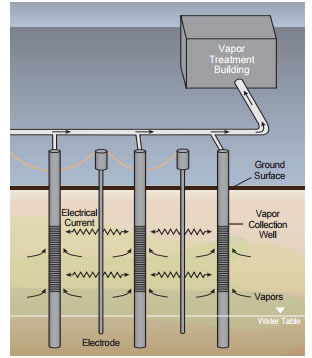Below are excerpts taken from EPA publication: Guide to In Situ Thermal Treatment
In situ thermal treatment methods move or “mobilize” harmful chemicals in soil and groundwater using heat. The chemicals move through soil and groundwater toward wells where they are collected and piped
to the ground surface to be treated using other cleanup methods. Some chemicals are destroyed
underground during the heating process. Thermal treatment is described as “in situ” because the heat
is applied underground directly to the contaminated area. It can be particularly useful for chemicals called “non-aqueous phase liquids” or “NAPLs,” which do not dissolve readily in groundwater and can be a source of groundwater contamination for a long time if not treated. Examples of NAPLs include solvents, petroleum, and creosote (a wood preservative).
How Does It Work?
In situ thermal treatment methods heat contaminated soil, and sometimes nearby groundwater, to very
high temperatures. The heat vaporizes (evaporates) the chemicals and water changing them into gases.
These gases, also referred to as “vapors,” can move more easily through soil. The heating process can
make it easier to remove NAPLs from both soil and groundwater. High temperatures also can destroy
some chemicals in the area being heated.
In situ thermal methods generate heat in different ways:
• Electrical resistance heating (ERH) delivers an electrical current between metal rods called
“electrodes” installed underground. The heat generated as movement of the current meets resistance from soil converts groundwater and water in soil into steam, vaporizing contaminants.
• Steam enhanced extraction (SEE) injects steam underground by pumping it through wells drilled in
the contaminated area. The steam heats the area and mobilizes and evaporates contaminants.
• Thermal conduction heating (TCH) uses heaters placed in underground steel pipes. TCH can heat the contaminated area hot enough to destroy some chemicals.
How Long Will It Take?
In situ thermal treatment might take a few months to a few years to clean up a site. The actual cleanup time will depend on several factors. For example, it might take longer where:
• Contaminant concentrations are high.
• The contaminated area is large or deep.
• A variety of soil types are present, causing the ground to heat unevenly.
• The soil has a lot of organic matter, which causes chemicals to stick to the soil and not evaporate easily.
Why Use In Situ Thermal Treatment?
In situ thermal treatment methods speed the cleanup of many types of chemicals, and are among the few in situ methods that can clean up NAPLs. Thermal treatment can be used in silty or clayey soil where other cleanup methods do not perform well. They also can reach contamination deep underground or beneath buildings, which would otherwise be difficult or costly to dig up to treat above ground.
More information on XDD Environmental’s thermal experience and services.

